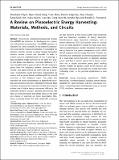A Review on Piezoelectric Energy Harvesting: Materials, Methods, and Circuits
Author(s)
Priya, Shashank; Song, Hyun-Cheol; Zhou, Yuan; Varghese, Ronnie; Chopra, Anuj; Kim, Sang-Gook; Kanno, Isaku; Wu, Liao; Ha, Dong Sam; Ryu, Jungho; Polcawich, Ronald G.; ... Show more Show less
Downloadehs-AReviewonPiezoelectricEnergyHarvesting.pdf (6.615Mb)
PUBLISHER_POLICY
Publisher Policy
Article is made available in accordance with the publisher's policy and may be subject to US copyright law. Please refer to the publisher's site for terms of use.
Terms of use
Metadata
Show full item recordAbstract
Piezoelectric microelectromechanical systems (PiezoMEMS) are attractive for developing next generation self-powered microsystems. PiezoMEMS promises to eliminate the costly assembly for microsensors/microsystems and provide various mechanisms for recharging the batteries, thereby, moving us closer towards batteryless wireless sensors systems and networks. In order to achieve practical implementation of this technology, a fully assembled energy harvester on the order of a quarter size dollar coin (diameter=24.26 mm, thickness=1.75 mm) should be able to generate about 100 μW continuous power from low frequency ambient vibrations (below 100 Hz). This paper reviews the state-of-the-art in microscale piezoelectric energy harvesting, summarizing key metrics such as power density and bandwidth of reported structures at low frequency input. This paper also describes the recent advancements in piezoelectric materials and resonator structures. Epitaxial growth and grain texturing of piezoelectric materials is being developed to achieve much higher energy conversion efficiency. For embedded medical systems, lead-free piezoelectric thin films are being developed and MEMS processes for these new classes of materials are being investigated. Non-linear resonating beams for wide bandwidth resonance are also reviewed as they would enable wide bandwidth and low frequency operation of energy harvesters. Particle/granule spray deposition techniques such as aerosol-deposition (AD) and granule spray in vacuum (GSV) are being matured to realize the meso-scale structures in a rapid manner. Another important element of an energy harvester is a power management circuit, which should maximize the net energy harvested. Towards this objective, it is essential for the power management circuit of a small-scale energy harvester to dissipate minimal power, and thus it requires special circuit design techniques and a simple maximum power point tracking scheme. Overall, the progress made by the research and industrial community has brought the energy harvesting technology closer to the practical applications in near future.
Keywords: energy harvesting; piezoelectric; MEMS; PiezoMEMS; electromechanical coupling; power density; epitaxial PZT; grain texturing; lead-free; non-linear resonance; aerosol deposition (AD)/granule spray in vacuum (GSV); cantilever; maximum power point
Date issued
2019-01-02Department
Massachusetts Institute of Technology. Department of Mechanical EngineeringJournal
Energy Harvesting and Systems
Publisher
Walter de Gruyter GmbH
Citation
Priya, Shashank et al. “A Review on Piezoelectric Energy Harvesting: Materials, Methods, and Circuits.” Energy Harvesting and Systems 4, 1 (January 2017)
Version: Final published version
ISSN
2329-8774
2329-8766